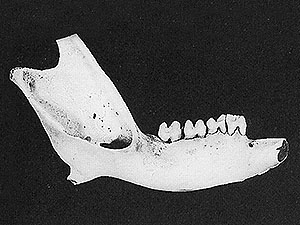Nullabor Dwarf Bettong (Bettongia pusilla)
The Nullabor Dwarf Bettong was described in 1997 based on subfossil skeletal remains that were found in caves on the Nullabor Plain, an large arid desert region in southern Australia.
The species apparently disappeared shortly after the arrival of European settlers in the region, who brought with them cats and foxes which preyed upon the native mammals and still do so up to this day.
***
The native people of the Pilbara region allegedly have two names for a very small kangaroo species, weelba respectively wirlpa, which may have originally been used for this species. [1]
*********************
References:
[1] Chris Johnson: Australia’s Mammal Extinctions: a 50000 year history. Cambridge University Press 2006
*********************

(under creative commons license (3.0))
http://creativecommons.org/licenses/by-nc-sa/3.0
*********************
edited: 29.05.2019

